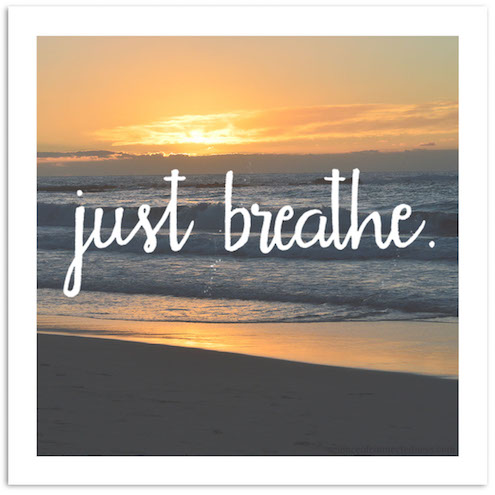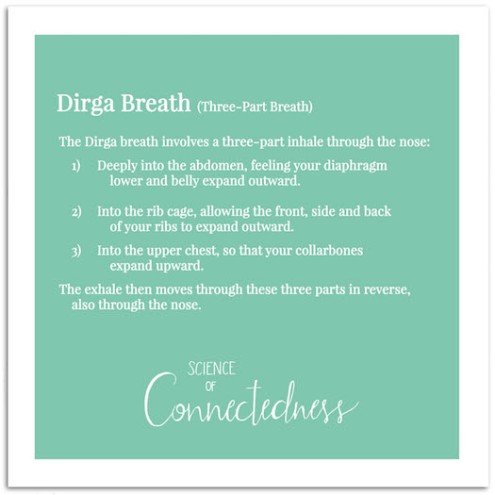
My goal for this blog is to share spiritual tools that I have discovered and am continuing to discover through my research and personal seeking. To begin, I am writing about the tool I see as foundational for all other spiritual tools: conscious breathing. (Interestingly, something I did not realize before researching for this blog post, is that the term spirituality is actually derived from the Latin word spiritus, which means breath![i])
Breathing is directly tied to our existence (we need to breathe to stay alive), it is a simple tool (inhale, exhale, repeat), and it can be used anywhere (except underwater or in space without the right equipment 😉 ). Feeling nervous at the dentist? Breathe. Getting tired while exercising? Breathe. Feeling annoyed with your partner? Breathe. Wanting to savor a precious moment? Breathe.
Conscious breathing, that is, breathing with purposefully relaxed awareness, is grounding; it brings you immediately to the present, and being present is essential for cultivating Connectedness (aka how I define spirituality). If your thoughts are always distracted by the what-ifs of the future or remembrance of the past, it is difficult—if not impossible—to also feel a connection with the present. Yet, the present is where those four relationships of Connectedness primarily reside. When you feel a connection to a community, it is not so much about your memories of the past or your hopes for the future; it is about feeling a connection in the presence of that community. Same with nature—it is about actually getting into a natural environment and noticing the Connectedness while you’re there. In order to notice, you need to be aware; in order to be aware, you need to be present; and in order to be present, one of the best tools is conscious breathing!
Now, what exactly do I mean by consciously breathing?
Well, our brains naturally control our breathing without us having to consciously regulate it (thank goodness). However, it is also possible to control our breathing, like when we choose to hold our breath or take a really big inhale or just generally think about ourselves breathing (I bet you’re noticing your breathing right now). When I say conscious breathing, I mean purposefully breathing in a relaxed way, with full awareness of each inhale and exhale. Your conscious mind is controlling the rate of your breath, but it is not forceful breathing nor should it feel strained; rather, it is breathing with awareness.
There are many different varieties of conscious breathing. In this post, I am going to focus on the main one from the yogic tradition called the Dirga or Three-Part Breath, which is my favorite and is fundamental for many other varieties. I have created the following image of Dirga Breath instructions:

Initially, when learning this type of breath, it can be helpful to separate the parts and even place a hand on each area as you do, first inhaling into the abdomen then exhaling, second inhaling with a focus on expanding your ribs then exhaling, and third inhaling into the top cavity and clavicle area before exhaling once more. Once you have consciously tried inhaling into all three areas, you can string them together into one long inhale that expands first your abdomen then ribs then upper chest, at which point you can pause briefly before slowly letting yourself exhale in reverse order. Ideally, the inhale of the Dirga breath takes at least six seconds (two seconds per section) and the exhale takes the same amount of time or longer—it is particularly beneficial when the exhale is slower than the inhale.[ii]
This type of breathing is a central part of yoga, especially Hatha yoga, and it is regularly used in meditation. However, I have also found it can be useful in day-to-day situations: I’ve used this breath to calm myself before a test; I’ve used this breath while jogging and hiking; and I’ve used this breath regularly to become present, aware, and open to experiencing Connectedness. In addition, regular use of the Dirga breath has many mental and physical benefits, such as increasing emotional regulation, decreasing anxiety, lowering respiratory rate, increasing maximum lung capacity, making the oxygen and carbon dioxide exchange in your lungs more efficient, etcetera![iii]
Ultimately, conscious breathing, and the Dirga breath in particular, are foundational for fostering Connectedness and cultivating peace, happiness, and well-being. Hope you get as much use out of this tool as I do, but if not, stay tuned for next week’s tool—maybe that one will be more suited to you. Additionally, if you have any tools that are essential to your spiritual practice, send me a message! I would love to hear about them 🙂
Happy breathing!
Sarah
[i] Hill, P. C., Pargament, K. I., Hood, R. R., McCullough, M. E., Swyers, J. P., Larson, D. B., & Zinnbauer, B. J. (2000). Conceptualizing religion and spirituality: Points of commonality, points of departure. Journal for the Theory of Social Behaviour, 30, 51-77.
[ii] Sengupta, P. (2012). Health impacts of yoga and pranayama: A state-of-the-art review. International journal of preventive medicine, 3(7).
[iii] Gerber, P. L., Goodies, L., and Brown, R. P. (2014).Mind-Body Practices and the Neuro-psychology of Wellbeing. In C. Kim-Prieto (Ed.), Religion and Spirituality Across Cultures (pp. 227-246).

[…] for my “Autumn New Year,” I realized I have not been prioritizing hiking, meditation, or conscious breathing as much as I would like, so I am now making more of an effort to include these practices in my […]
LikeLike